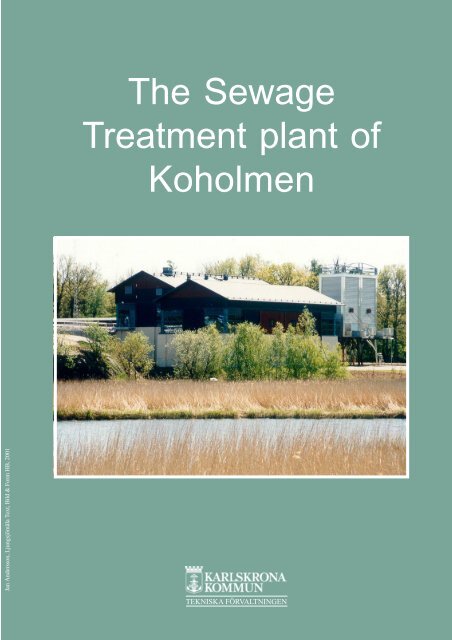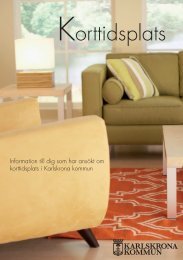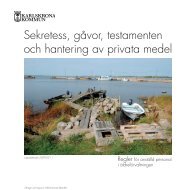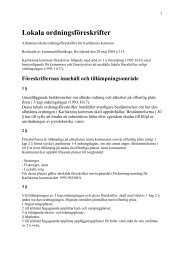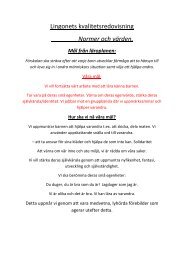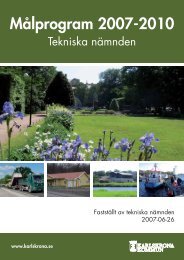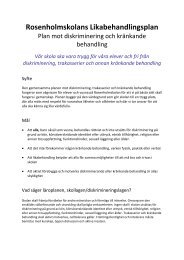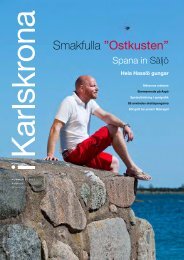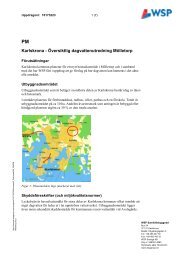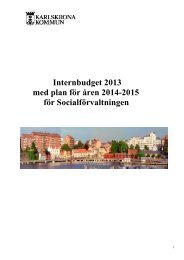The Sewage Treatment plant of Koholmen
The Sewage Treatment plant of Koholmen
The Sewage Treatment plant of Koholmen
Create successful ePaper yourself
Turn your PDF publications into a flip-book with our unique Google optimized e-Paper software.
<strong>The</strong> <strong>Sewage</strong><strong>Treatment</strong> <strong>plant</strong> <strong>of</strong><strong>Koholmen</strong>Jan Andersson, Ljungsjömåla Text, Bild & Form HB, 2001TEKNISKA FÖRVALTNINGEN
<strong>The</strong> <strong>Sewage</strong> <strong>Treatment</strong> Plant <strong>of</strong> <strong>Koholmen</strong>Intake PumpingStationInlett Cleansing Grill Sand and Grease Trap Bio-tanks Intermediate Sedimentation Sedimentation by Precipitation Sand Filter OutlettReturn SludgeChemical SludgeSludge Holding TankSeparated pollution and sand to deportation Excess Sludge Dehydration Spin-dryer Slamgödsel<strong>The</strong> <strong>Koholmen</strong> sewage treatment <strong>plant</strong> was built in 1995/96 and was put into operation in the winter <strong>of</strong>1996/97.<strong>The</strong> sewage treatment <strong>plant</strong> is dimensioned for pollution stress equivalent to about 60.000 people andreplaces several older sewage treatment <strong>plant</strong>s. Besides Karlskrona the sewage treatment <strong>plant</strong> alsoserves the populated areas <strong>of</strong> Lyckeby, Rödeby, Spjutsbygd and Nättraby.<strong>The</strong> purification effect is about 75% for nitrogen and more than 95% for organic material and phosphorus.<strong>The</strong> <strong>Koholmen</strong> sewage treatment <strong>plant</strong> is the heart <strong>of</strong> the modernized system for handling sewage fromcentral Karlskrona, built for the demands <strong>of</strong> the 21st century regarding an adjusted cycle <strong>of</strong> water andsewage handling.<strong>The</strong> purification process, which is mainly based upon biological processes, is very flexible and can beadjusted to variations in flow and amount <strong>of</strong> pollution as well as changed strategies <strong>of</strong> operation.<strong>The</strong> shaping <strong>of</strong> the process gives good conditions for the return <strong>of</strong> nutritive substances in a closed cyclebetween city and countryside.<strong>The</strong> foul water to the <strong>Koholmen</strong> sewage treatment <strong>plant</strong> comes from central Karlskrona and the villages<strong>of</strong> Lyckeby, Rödeby, Nättraby and Spjutsbygd. This corresponds to approximately 40.000 people.<strong>Sewage</strong> water from most <strong>of</strong> the larger companies in the municipalities is also included.In order to keep a regular flow there are two stores which make adjustments possible by the pumpstations in Gullberna and Vämöviken. From these the sewage is pumped to <strong>Koholmen</strong> in two pipes.Each pipe can transport at the most 1.500 cubic meter sewage per hour. But the calculated normal flowis much less, in total about 700 cubic meters per hour.At extreme flows, more than 2.000 cubic meters per hour, which can temporarily set in, in for examplevery rainy weather, some <strong>of</strong> the sewage must be conveyed past the biological purification step. For thispurpose there is a third pipe as a security measure.Data <strong>of</strong> DimensioningQS tress <strong>of</strong> flow:S tress <strong>of</strong> pollution : Content <strong>of</strong> discharge :averageQ dim16000 m 3/ dBOD250mg/ lBOD7 < 10 mg/ l71 000 m 3/ dPhosphorus12 mg/ lNitrogen 42mg/lPhosphorus< 0,3 mg/ lNitrogen < 12 mg/ l
Mechanical Purification - Cleansing GrillFirm pollution such as paper, tops, sanitary pads, etc are separated in two cleansing grills. <strong>The</strong>y serve asstrainers with a slit breadth <strong>of</strong> two millimeters and are automatically cleaned. <strong>The</strong> trimmings are thentransported by screwfeeding to a container for further transportation to the deposit works in Bubbetorp.<strong>The</strong> third cleansing grill is used for sludge from small sewage treatment <strong>plant</strong>s that don’t have sludgehandling <strong>of</strong> their own.<strong>The</strong> cleansing grills are placed on the highest level in the purification process. <strong>The</strong> inlet pumps at Vämöand Gullberna press the sewage water here through climbing shafts. Thus the water is then able to passthe process by itself even if <strong>Koholmen</strong> were to be exposed to a power failure.Firm pollution in the sewage water causes many disturbances in the operation. <strong>The</strong>refore youare not allowed to flush down tops, sanitary pads, hair, cotton waste or other firm objects whichcan stop up the pipes or damage the purification process. Instead throw that kind <strong>of</strong> waste inthe garbage. A practical tip is to have a little waste can in the bathroom.Illustration: Pär Samuelsson
Mechanical Purification - Sand- and Grease TrapFrom the thin lattice works the sewage water runs to two parallel sand- and grease traps. On the bottom<strong>of</strong> these the admixture <strong>of</strong> air takes place. Lipids in the sewage water rise to the surface and are removedby panicle furrows. However, sand, c<strong>of</strong>fee grounds and other small heavy particles sink to the bottom.<strong>The</strong> separated lipids are collected in a well, from which a lorry then removes them and transports themto be deposited.<strong>The</strong> heavier particles are after dehydration taken to the same container as the one where the wastefrom the cleansing grills is collected.Panicle Vipprännor furrowsGrease Fettbrunn WellBubbetorpDehydration AvvattningSand and Grease trap, principle. Illustration: Jan Andersson
<strong>The</strong> Bypass <strong>of</strong> <strong>Sewage</strong> WaterAfter the mechanical handling, where all incoming sewage water passes, there is the possibility to lead thesewage water past the biological handling step. This is necessary at big flows, more than 2.000 cubicmeters per hour. Otherwise the biological processes will be damaged. A partial flow <strong>of</strong> the mechanicallypurified water is then led to the tank <strong>of</strong> sedimentation (by precipitation) for chemical handling and thefollowing sedimentation and filtration. If necessary a smaller part <strong>of</strong> the mechanically purified water canalso be led to the outlet pipe.Fortunately, bypassing <strong>of</strong> sewage water is most unusual and occurs on average only once year.<strong>The</strong> biological processes are dimensioned for a normal flow <strong>of</strong> about 700 cubic meters per hourand a maximum flow <strong>of</strong> 2.000 cubic meters per hour at the most. Should the flow be higher, theexcess part <strong>of</strong> the mechanically purified water will be led directly to chemical precipitation.Photo: Jan Andersson
Biological Handling - Two Bio Lines<strong>Koholmen</strong> has two separate process lines for the biological handling. <strong>The</strong> sewage water can be dividedin different ways between the two bio lines. It is managed by means <strong>of</strong> a rudder that direct the amount <strong>of</strong>water to the bio lines. It is possible to shut <strong>of</strong>f the flow to a line completely when repairs are necessary orto protect the microorganisms from harmful substances, if such should be discovered in the sewagewater. Active microbes can then be conveyed between the bio lines in order to quickly restore fullbiological activity.Each bio line has a volume <strong>of</strong> roughly 10.000 cubic meters. That means the sewage water stays in thebio basins for about 36 hours at normal flow.By means <strong>of</strong> a rudder the stream <strong>of</strong> sewage water can be divided in different ways between thetwo parallel bio lines <strong>of</strong> the sewage treatment <strong>plant</strong>. Illustration: Jan Andersson
Biological Handling - Principle<strong>The</strong> main purification <strong>of</strong> the sewage water takes place in the biological handling steps. Differentnaturally occurring microorganisms, chiefly bacteria, which come in via the sewage water and thenmultiply in the bio tanks, carry out the purification. <strong>The</strong> microorganisms that take part in the purificationprocess are extremely specialized and have each different demands on the environment. <strong>The</strong>reforeconditions are created in the bio tanks that best favour those bacteria cultures wanted. By pumpingback those bacteria that are separated further on in the process a very high concentration <strong>of</strong>microorganisms is obtained in the bio basins. <strong>The</strong>reby the work <strong>of</strong> the microorganisms will be carriedout in one place and with much higher speed than in natural systems.Different microorganisms carry out the purification. In the bio basins conditions are created thatfavour those bacteria cultures wanted. Illustration: Pär Samuelsson
Biological Handling - DesignSome bacteria require much oxygen, while others have to be forced to work with lack <strong>of</strong> oxygen. <strong>The</strong>reforedifferent zones are created in the bio lines with regard to the content <strong>of</strong> oxygen.<strong>The</strong> water is recirculated several times between different zones in the biological handling <strong>of</strong> the sewagewater. This is done because some biological processes have to be carried out in reversed order againstthe flow <strong>of</strong> the water through the bio lines. Moreover, because <strong>of</strong> the recirculation, the sewage water ishandled more than once, which gives a better purification effect. To prevent the microorganisms fromsinking the water is mixed by powerful stirrers. However, in the zones that are mixed with air, nomechanical means are needed, since the admixture <strong>of</strong> air is enough to keep the microbes floating. <strong>The</strong>mixing also gives a good contact between the bacteria and those substances that are to be brokendown.Anaerob Anox AerobIn the anaerobic zone there is no oxygen. In the anoxic zone there is oxygen only incombination with nitrate [NO - 3 ]. while there in the aerobic zone are dissolved oxygen molecules[O 2 ] in the water. <strong>The</strong> two recirculation streams increase the flow through the bio tanks byapproximately four times, which enables different biological processes to take place at the sametime. Illustration: Jan Andersson
Biological Handling - Breaking Down<strong>The</strong> without comparison largest pollution amount in the sewage water consists <strong>of</strong> organic material. <strong>The</strong>major part <strong>of</strong> this is broken down by microorganisms in the oxygen rich (aerobic) parts <strong>of</strong> the bio tanks.<strong>The</strong> breaking down <strong>of</strong> the organic material in the sewage treatment <strong>plant</strong> comes about in the same way asin natural systems. In principle the breaking down is identical with the ”combustion” <strong>of</strong> organic material(carbohydrates) which takes place in the cells <strong>of</strong> both <strong>plant</strong>s and animals. <strong>The</strong> process can briefly bedescribed in the following way:BacteriaCH 2 O + O 2 => CO 2 + H 2 O + EnergyCarbohydrate Oxygen Carbon Dioxide Water Growth<strong>The</strong> process is very oxygen-demanding and to make it possible for the bacteria to manage to break downthe organic pollution in a short time, oxygen is added to some parts <strong>of</strong> the bio tanks.When breaking down organic pollution, bacteria utilize the chemical energy that is releasedduring the process. <strong>The</strong>reby they get power to grow and propagate. From the pollution thereonly remain carbon dioxide, water and more bacteria [sludge]. Illustration: Pär Samuelsson
Biological Handling - NitrificationIn the sewage water there are large amounts <strong>of</strong> nitrogen in the shape <strong>of</strong> the <strong>plant</strong> nutritive substanceammonium [NH + 4 ]. During the purification process this nitrogen is released and turned into ordinarynitrogen gas [N 2 ], which normally isn’t fit to serve as a nitrogen source for the <strong>plant</strong>s. But to makesuch a release possible, the nitrogen must exist as nitrate [NO - 3 ]. <strong>The</strong>re are, however, bacteria thatextract energy by transforming ammonium into nitrate. <strong>The</strong> process, which is called nitrification iscarried out in two steps by different bacteria:NH + 4 + 1,5 O 2 => NO - 2 + H 2 O + 2H+ + EnergyAmmonium Oxygen Nitrite Water Hydrogen GrowthNO - 2 + 0,5 O 2 => NO- 3 + EnergyNitrite Oxygen Nitrate GrowthCompared with other bacteria the nitrification bacteria grow very slowly. For this reason the zonemixed with air is considerably larger than other zones.NitrateHydrogenNitriteOxygenAmmoniumIn the oxygen-rich zones <strong>of</strong> the bio basins ammonium nitrogen is transformed into nitrate nitrogenby special bacteria, which hereby get access to energy. <strong>The</strong> process is carried out in twosteps with nitrite as intermediate product. Illustration: Pär Samuelsson
Biological Handling - Nitrogen PurificationFor nitrogen purification <strong>of</strong> the sewage water bacteria are used that have the capacity for growingeven if the water lacks oxygen. <strong>The</strong>y manage by instead using the oxygen that is available in nitratenitrogen [NO - 3 ] for the (for survival) essential combustion <strong>of</strong> organic material. When this happensthe nitrogen is released and rises as harmless nitrogen gas [N 2 ] up in the air. This phenomenon,denitrification, also takes place in natural systems and can be seen as an alternative for the bacteriato manage growth in an environment lacking free oxygen. However, if free oxygen is provided thedenitrification will stop immediately. Nitrogen purification through denitrification is thus onlypossible with access to organic material and nitrate in an environment lacking free oxygen. <strong>The</strong>seconditions are created in the anoxic zones in the bio tanks. Here no admixture with air takes placeand to these zones the nitrate rich water is pumped from the aerobic areas.nitrogengasOxygenNitrateIn the zone deficient in oxygen, oxygen only exists in combination with nitrate. When thebacteria are forced to use this oxygen, the nitrogen is released and rises as harmless nitrogengas up in the air. Illustration: Pär Samuelsson
Biological Handling - Phosphorus PurificationWith the help <strong>of</strong> so-called Bio-P-bacteria phosphorus can be separated in the biological handling step.<strong>The</strong>se microorganisms have the ability to take up large amounts <strong>of</strong> phosphorus in the shape <strong>of</strong> energyrich polyphosphate when there is access to free oxygen. <strong>The</strong> phosphorus absorption thus takes placein the oxygen rich (aerobic) zones in the bio tanks. When the Bio-P-bacteria through recirculation <strong>of</strong>the sewage water come into the oxygen-deficient zones (anaerobic zones), they can use the storedenergy for absorption <strong>of</strong> easy degradable organic material. <strong>The</strong>reby phosphorus will be released, butwhen the Bio-P-bacteria again come into the oxygen-rich zone they can ”burn up” the stored easilydegradable material and thereby absorb more phosphorus. Consequently, in order to makephosphorus purification work, it is necessary with varied oxygen conditions and access to degradableorganic material.Biological phosphorus purification is carried out by special bacteria, which have the capacityfor taking up more phosphorus than they really need. Illustration: Pär Samuelsson
Take Care <strong>of</strong> the Bacteria!<strong>The</strong> microorganisms in the bio tanks break down more than 95 percent <strong>of</strong> the organic pollution intocarbon dioxide and water. <strong>The</strong>y also manage to transform about 75 percent <strong>of</strong> the <strong>plant</strong> nutritivesubstances ammonium and nitrate into harmless nitrogen gas. In addition they can catch more than half<strong>of</strong> the phosphorus that is in the sewage water. To make this work, the bacteria must, however, be in anon-toxic environment! If toxic waste gets into the sewage water, these valuable microbes will bedamaged. For this reason substances like oils, solvents, remainders from paint, photo chemicals,biocides, strong acid or strong alkaline fluids must never be poured into the drainage. Collect suchwaste in special reservoirs instead and leave these to the environmental stations <strong>of</strong> the municipality.If oils, solvents or other toxic waste get into the drainage, bacteria will be seriously damagedand die, if the worst comes to the worst. Illustration: Pär Samuelsson
Intermediate SedimentationWhen the sewage water leaves the bio basins it contains amounts <strong>of</strong> microorganisms that together formsludge. <strong>The</strong>refore the water is slowly led through six parallel sedimentation tanks, which enables thissludge to sink to the bottom. With chain scrapers the sludge is collected in sludge pockets, from whereit can be pumped away. Most <strong>of</strong> the sludge, normally about 10.000 cubic meters every twenty-fourhours, is transported as return sludge back to the bio basins so that the bacteria can continue to be <strong>of</strong>help there. <strong>The</strong> part that corresponds to bacteria growth must on the other hand be removed from theprocess as surplus sludge. <strong>The</strong> exact amount <strong>of</strong> sludge that is to be removed is decided by the readings<strong>of</strong> the sludge gauges <strong>of</strong> the base tanks. Normally the surplus amount is about 400 cubic meters everytwenty-four hours. <strong>The</strong> sewage water is led further on through furrows.FurrowsChain scraperSludgepocketIn the intermediate sedimentation microorganisms are separated by sinking to the bottom assludge. With the help <strong>of</strong> chain scrapers the sludge is collected in sludge pockets, from wheremost <strong>of</strong> it is then pumped back to the bio tanks. Illustration: Jan Andersson
Sedimentation (by Precipitation) and Final Sedimentation<strong>The</strong> water from the intermediate sedimentation looks clean, but some pollution remains, mainlyphosphorus, left in the shape <strong>of</strong> small particles and molecules. With the help <strong>of</strong> precipitation chemicals(metal salts) you can make such small particles form lumps. After mixing the chemical attaches itself tothe pollution, which results in these being tied together into larger particles which are possible toseparate. At <strong>Koholmen</strong> aluminium salts are used as precipitation chemicals. <strong>The</strong> addition <strong>of</strong> chemicalstakes place in special tanks <strong>of</strong> Sedimentation by Precipitation. <strong>The</strong> chemicals are mixed in duringpowerful stirring. After that a slower stirring takes place at which the pollution sticks together insnowflake-like particles. In the following final sedimentation the particles sink to the bottom as sludge,which is then pumped back to the bio basins.To be able to separate small pollution particles which are dissolved in water, aluminium saltsare used as precipitation chemicals This makes small particles stick together in larger particlesthat are possible to separate. Illustration: Pär Samuelsson
Sand Filter and Outlet PipeAs a final step there are seven sand filters in the purification process. Here the almost totally pure waterflows through a sand bedding where possible remainders from the sedimentation (by precipitation) areefficiently caught by the sand. With that the water is clean. At normal operation, the purification processmanages to remove:about 99 percent <strong>of</strong> organic material;about 96 percent <strong>of</strong> the amount <strong>of</strong> phosphorus;about 75 percent <strong>of</strong> the amount <strong>of</strong> nitrogen.<strong>The</strong> purified water is led in a four and a half kilometer long outlet pipe, ending on the depth <strong>of</strong> 20 meterssouth <strong>of</strong> Verkö. With the help <strong>of</strong> streams at the bottom <strong>of</strong> the sea the water is carried out <strong>of</strong> theKarlskrona archipelago.<strong>The</strong> outlet pipe from the <strong>Koholmen</strong> sewage treatment <strong>plant</strong> is four and a half kilometer long. Itwas built at quay and was towed in sections out to sea. <strong>The</strong> pipe is held in place with concreteblocks. Photo: Jan Andersson
Sludge Handling<strong>The</strong> surplus sludge contains large amounts <strong>of</strong> water, which is removed by the first dehydration and incentrifuges. <strong>The</strong> first dehydration works as strainers where some <strong>of</strong> the water flows through. <strong>The</strong> wateris hurled from the sludge in the rapidly rotating centrifuges as a consequence <strong>of</strong> the centrifugal force.During the dehydration the volume decreases from about 400 to 16 cubic meters every twenty-fourhours. <strong>The</strong> water that is removed, is led back to the bio basins, while the sludge is taken to a sludgestore awaiting further transportation. <strong>The</strong> <strong>Koholmen</strong> sewage water treatment works yearly producesabout 6.000 cubic meters sludge, which is continuously controlled by the taking <strong>of</strong> samples and analyses.<strong>The</strong> sludge is <strong>of</strong> very good quality and thereby approved for spreading on arable land byagreement between LRF (the Federation <strong>of</strong> Swedish Farmers), Naturvårdsverket (the Swedish NationalEnvironment Protection Board) and the branch <strong>of</strong> Water and <strong>Sewage</strong>.<strong>The</strong> sludge from the <strong>Koholmen</strong> sewage water treatment works is a perfect fertilizer andapproved to be spread on arable lands. <strong>The</strong>reby we can close the cycle <strong>of</strong> nutritive substancesbetween city and countryside. Illustration: Pär Samuelsson
Chemical HandlingPrecipitation ChemicalsTo remove (precipitate) the remainders <strong>of</strong> phosphorus which the biological treatment has not managed todo, aluminium salt solutions are used. <strong>The</strong>se are dosed in proportion to the flow through the treatmentworks. Depending on the operational situation, three different dosage places can be chosen. Simultaneousprecipitation takes place in the bio basins during periods when the biological phosphorus purificationdoesn’t work well enough. Depending on the choice <strong>of</strong> precipitation chemical, precipitation takes placeon other occasions, such as afterprecipitation in the sedimentation step or as precipitation on filters at theinlet <strong>of</strong> the sand filters.PolymersPolymers are needed to reach a good result when dehydrating sludge. Polymers consist <strong>of</strong> elongated,<strong>of</strong>ten charged hydrocarbon molecules, which make the sludge stick together and become more waterrepellent. Hereby it is possible to enhance the dry content in the final sludge manure, which makes thehandling easier and reduces the transportation costs.<strong>The</strong> polymer solutions are made <strong>of</strong> firm or liquid polymers. In the treatment works there are twoseparate systems for preparation, which means that different polymer solutions can be used at the firstdehydration and the centrifuging, respectively.Bio Tanks Intermediate Sedimentation Final Sedimentation Sand FilterSimultaneous Simultanfällning precipitate After Efterfällning precipitate Fällning Precipitate före on filtersReturnReturslamSludge ChemicalKemslamSludge Sludge Slamlager Holding TankExcess Överskottslam Sludge Dehydration Föravvattning Spin Centrifug DryerSlamgödsPolymerPolymer
Instrument readings and Taking <strong>of</strong> SamplesPumpstationerGullberna ochVämövikenInlopp Fingaller Sand/fettfång Bio-bassänger Mellansedimentering Flockning Slutsedimentering Sandfilter Värmepump UtloppFlowSampleFlödeProvSlamhalt Sludge Syrehalt Oxygen Sample Prov Sample ProvReturslamKemslamSlamlagerFlow FlödeContainer för rens och sandÖverskottslamFöravvattning CentrifugSlamgödselFlow Flöde och and Slamhalt sludgeIn order to direct and control all processes <strong>of</strong> the sewage treatment <strong>plant</strong>, large amounts <strong>of</strong> collecteddata is required. <strong>The</strong>refore there are electronic sensors on different locations in the process whichmeasure flows, the amount <strong>of</strong> sludge, oxygen content, etc. Moreover, incoming biologically treated andpurified water is pumped here to the testing station for supplementary instrument readings and testing.All water that passes the sewage treatment <strong>plant</strong> is tested and analyzed by staff from the accreditedwater laboratory <strong>of</strong> the municipality. Samples from inlet and outlet are analyzed in order to find out thetotal purification effect. In the analyses <strong>of</strong> the biologically treated water mainly the remaining amounts<strong>of</strong> ammonium are measured. Those results reflect the effect <strong>of</strong> the nitrogen purification and affect thechoice <strong>of</strong> operation strategy.At the treatment works different instrument readings and tests are carried out continuously inorder to always be able to direct the processes for best water purification.Illustration: Pär Samuelsson
Control Room - Computer Support<strong>The</strong> computer at <strong>Koholmen</strong> directs all machines in the sewage water treatment <strong>plant</strong> with the help <strong>of</strong>incoming signals from registration instruments. Most <strong>of</strong> the changes <strong>of</strong> the process can be madedirectly via the computer, which is also responsible for monitoring all process steps, day and night. Ifthe computer were to note abnormal readings from any instrument it would send out an alarm signal.After normal working hours these alarms go to the staff on duty. All instrument readings are stored inthe computer for at least six months. <strong>The</strong>reafter all data are transferred to tapes. <strong>The</strong> stored informationis summed up in daily, monthly and annual reports, which are automatically printed out. <strong>The</strong>collected readings can also be used as basic data for trend graphs for all events in the process chain inan optional time period.<strong>The</strong> computer constantly directs, monitors and registers the purification processes. If anythingabnormal happens, it sends out an alarm to the staff. Illustration: Pär Samuelsson


